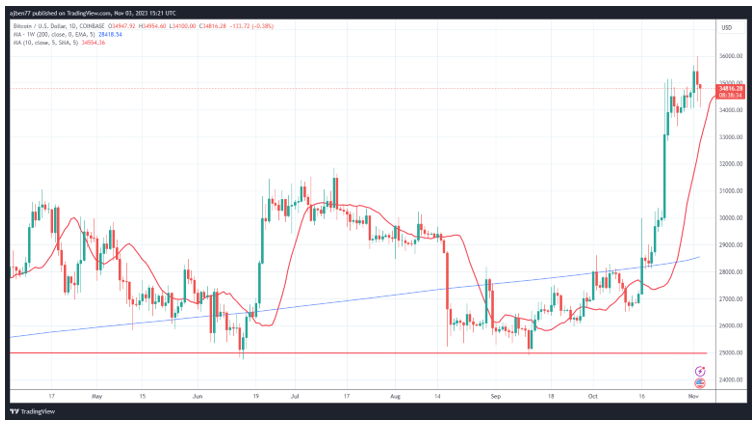Crypto Market Looks Ahead Following SBF’s Conviction
 |
| By Juan Villaverde |
Well, it’s finally done. The current trial of Sam Bankman-Fried, the founder of FTX — one of the largest centralized crypto exchanges and Alameda Research — has come to a close.
Seemingly appearing out of nowhere in the last bull cycle, FTX grew to compete on the same level as giants like Coinbase (COIN) and Binance, gobbling up loads of crypto trading volume.
In fact, it grew so large so quickly that when it collapsed, the failure of such a large exchange sent foundation-shaking shockwaves through the broad crypto market.
In the trial, the prosecution argued that SBF was responsible for that damage, as it alleged that he had misused customer funds, engaged in deceptive and manipulative practices and misrepresented the financial health of FTX and its associated trading firm, Alameda Research.
As such, SBF faced charges that included wire fraud, securities fraud and money laundering, among others.
To the shock of no one who has been paying attention, he’s been found guilty on all counts.
The guilty verdict marks a significant moment for the cryptocurrency industry, which has been under increased scrutiny following the high-profile collapse of FTX.
The industry — which has long prized its decentralization and lack of regulation — is now facing calls for tighter oversight to prevent similar incidents in the future.
I can already hear your hesitation. And you’re not alone. Most crypto enthusiasts are wary when hearing the term “regulation.” That’s because many central governments’ attempts at regulating the crypto space thus far have been ill-thought out and more harmful than helpful.
However, common sense regulation — such as clearer guidelines for exchanges, regular audits and stronger protections for customer funds — are needed and could lead to a more stable and mature crypto market.
More to the point right now, they can help broad crypto space regain public trust by putting a greater emphasis on transparency, accountability and regulatory compliance.
With the conviction of SBF and the crypto community showing support for judicial accountability, many are hoping this will start a new, more positive chapter regarding common sense regulation.
And sure enough, we’ve already seen some changes from regulators that suggest they might be ready to play ball with fair regulations.
This could all start with the approval of spot Bitcoin (BTC, "A-") ETFs, and new regulatory guidelines could follow.
We’ll have to wait and see how regulators proceed.
What’s Next
SBF won’t face sentencing until March of next year, and there are still further charges that he faces. This story isn't over, but it appears that the crypto industry is ready to close this chapter and move on to the next.
The industry is healing, and many altcoins that were more closely tied to FTX or Alameda have now returned to pre-collapse levels.
One of those alts is Solana (SOL, “C”).
Solana paid a heavy toll in reputational damage after the collapse of FTX, falling from its bear market range between $30 - $50 to below $8.
Many wondered in the aftermath if SOL — a darling of the previous bull market — would survive the rest of the crypto winter to make it to the next bull run.
Fortunately, as my colleague Alex Benfield explained on Wednesday, SOL has now rebounded back to about $40 from that low.

Its recent strength and the conclusion of the SBF trial have cleared the way forward. Now, SOL looks poised to take advantage of yet another bull run.
Solana is but one of many crypto projects that is now coming out on the other side of the FTX drama. The industry is healing itself.
And the timing is great, because Bitcoin has given us the signals we need to see to know that the bear market is now officially over.
It has been trading right around $35,000 for a few days now and has sustained this recent breakout. We still expect a correction to come sometime soon, but the odds of BTC breaking below its September low of $25,000 are very low.

The 200-week moving average is right below the $29,000 level and should act as a major support if Bitcoin corrects below support at $31,000.
We’re expecting the approval of spot Bitcoin ETFs to come sometime before the end of the first quarter of 2024. Then, Bitcoin’s halving will take place in April, and it's only a matter of time until the U.S. money printer turns back on in the face of macroeconomic pressures.
When that happens, the crypto market will be well-positioned for the rivers of liquidity that should flow in.
Best,
Juan

